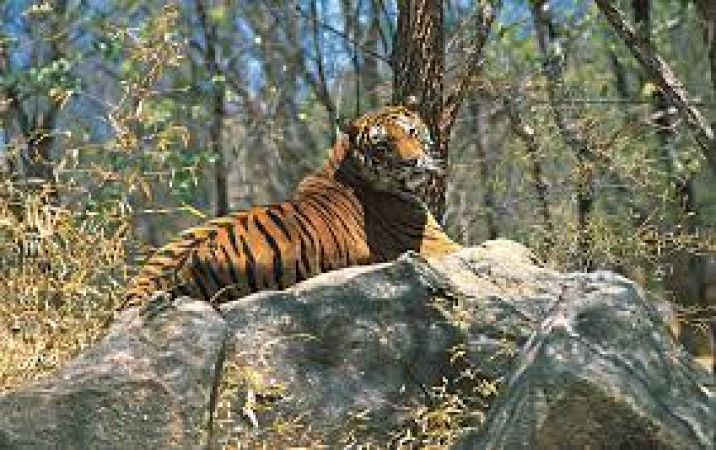
Pakhui Wildlife Sanctuary Travel Guide
Pakhui Wildlife Sanctuary, located in the eastern Himalayas of Arunachal Pradesh, India, is a haven for nature lovers and wildlife enthusiasts. Established in 1977, this sanctuary is renowned for its diverse flora and fauna, including Bengal tigers, Asiatic elephants, and various species of birds. The sanctuary's rugged terrain, dense forests, and rolling hills make it a paradise for adventure seekers and eco-tourists.Top Attractions in Pakhui Wildlife Sanctuary
- Jeep Safari to spot rare wildlife
- Trekking trails through lush greenery
- Birdwatching opportunities for ornithologists
- Visit to tribal villages for cultural insights
Pakhui Wildlife Sanctuary is Famous for
Its pristine natural beauty and rich biodiversity make Pakhui Wildlife Sanctuary a sought-after destination for wildlife enthusiasts and nature lovers.Top Attractions in Pakhui Wildlife Sanctuary
- Spotting Bengal tigers in their natural habitat
- Exploring the diverse flora and fauna
- Experiencing the local tribal culture
- Trekking through scenic landscapes
What's Great about Travelling to Pakhui Wildlife Sanctuary?
- Perfect destination for wildlife enthusiasts
- Opportunities for adventure activities like trekking
- Immersive cultural experiences with local tribes
What's Not So Great about Travelling to Pakhui Wildlife Sanctuary?
- Limited accommodation options
- Rough terrain may not be suitable for all travelers
- Remote location with limited amenities
Travel Tips for Pakhui Wildlife Sanctuary
- Obtain necessary permits for entry
- Follow safety guidelines during wildlife sightings
- Carry sufficient supplies for treks
Important Pakhui Wildlife Sanctuary trip information
- Ideal Duration: 3-4 days
- Best Time to Visit: October to April
- Nearby Airports and Railway Stations: Tezpur Airport (Assam) and Harmuti Railway Station (Assam)
FAQ's on Pakhui Wildlife Sanctuary
Q1: What is the best time to visit Pakhui Wildlife Sanctuary?
The best time to visit Pakhui Wildlife Sanctuary is during the winter months from November to February when the weather is pleasant and ideal for wildlife sightings. Avoid the monsoon season from June to September as heavy rains can make the terrain difficult to navigate. The sanctuary is closed during the summer months from March to May due to high temperatures.
Q2: Do I need a visa to travel to Pakhui Wildlife Sanctuary?
Foreign tourists visiting Pakhui Wildlife Sanctuary may require an Indian visa. It is recommended to check the visa requirements based on your nationality before planning your trip. Some nationalities are eligible for e-Visas or visa exemptions, but it's essential to verify the latest regulations with the Indian embassy or consulate.
Q3: What are the must-visit attractions in Pakhui Wildlife Sanctuary?
Some of the must-visit attractions in Pakhui Wildlife Sanctuary include the diverse flora and fauna, especially the Royal Bengal Tigers, elephants, and various bird species. Don't miss the Pakhui Wildlife Sanctuary Museum for insights into the local biodiversity. Trekking in the sanctuary and exploring the lush forests are popular activities for nature enthusiasts.
Q4: Is Pakhui Wildlife Sanctuary a safe place to travel?
Pakhui Wildlife Sanctuary is generally safe for tourists. However, it is essential to follow safety guidelines provided by authorities, especially during wildlife safaris. Avoid straying from designated paths and maintain a safe distance from wild animals. It's advisable to hire experienced guides for a safe and enjoyable experience.
Q5: What is the local currency in Pakhui Wildlife Sanctuary and can I use credit cards?
The local currency in Pakhui Wildlife Sanctuary is the Indian Rupee (INR). While credit cards may be accepted in some hotels and larger establishments, it is recommended to carry cash for smaller purchases and transactions. ATMs may not be widely available in remote areas, so it's advisable to plan for cash requirements in advance.
Q6: What is the local cuisine like in Pakhui Wildlife Sanctuary?
The local cuisine in Pakhui Wildlife Sanctuary reflects the flavors of Arunachal Pradesh, with dishes featuring rice, bamboo shoots, and locally sourced meats. Try traditional dishes like Thukpa (noodle soup), Apong (local rice beer), and Momos (dumplings). Vegetarian options are also available. Travelers with dietary restrictions should inform restaurants in advance for suitable meal options.
Q7: What transportation options are available in Pakhui Wildlife Sanctuary?
Transportation options in Pakhui Wildlife Sanctuary include local buses, taxis, and private car rentals. Hiring a local guide or driver is recommended for navigating the sanctuary and reaching remote areas. Public transport may have limited schedules, so it's advisable to plan transportation arrangements in advance for a convenient travel experience.
Q8: Are there any cultural norms or etiquette I should be aware of when visiting Pakhui Wildlife Sanctuary?
When visiting Pakhui Wildlife Sanctuary, it's essential to respect the local culture and customs of the tribal communities. Dress modestly, especially when visiting villages or religious sites. Seek permission before taking photographs of locals. Avoid littering and maintain the sanctity of the natural surroundings. Greeting people with a smile and showing appreciation for the local traditions will enhance your travel experience in Pakhui Wildlife Sanctuary.
Q9: I am a travel agent. How can I buy travel leads of Pakhui Wildlife Sanctuary?
Register yourself as a travel agent at agents.tripclap.com and then you can buy travel leads to Pakhui Wildlife Sanctuary once your account is approved. For more details contact our support team at +91-8069186564 or support@tripclap.com
